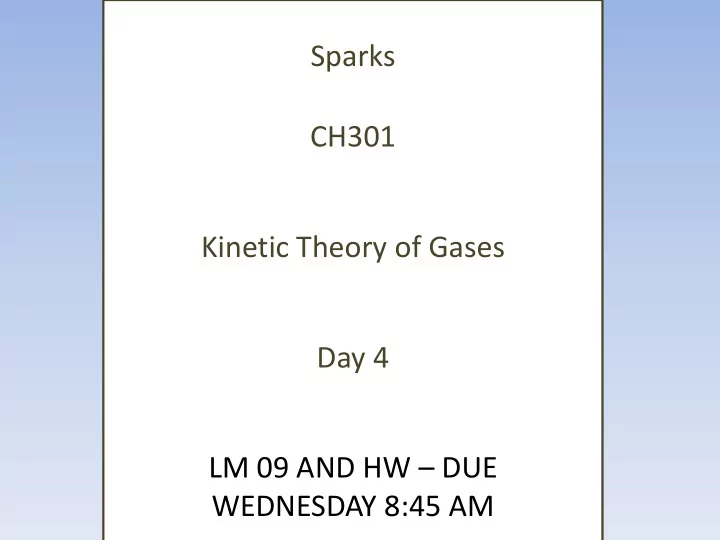

Sparks CH301 Kinetic Theory of Gases Day 4 LM 09 AND HW – DUE WEDNESDAY 8:45 AM
QUIZ: CLICKER QUESTION • In a mixture of one mole of He and one mole of Ar, the partial pressure of the Ar compared to the partial pressure of He is ? A.The same B.Higher C.Lower
POLL: CLICKER QUESTION After reading through the question on an in- class learning activity, I typically… A) Wait for the answer to be given then write down the correct answer. B) Start by thinking about the chemistry principles that apply then begin working on a solution. C) Begin by looking through my notes for the right formula that applies then plugging in the numbers to get an answer. D) Google the topic to find a similar problem then use that as a guide for solving this problem.
What are we going to learn today? Understanding the Kinetic Molecular Theory Relating T, KE, and velocities of particles • Explain the relationship between T and KE • Explain how mass and temperature affect the velocity of gas particles • Recognize that in a sample of gas, particles have a distribution of velocities • Explain the tenets of Kinetic Molecular theory • Apply differences in gas velocity to applications such as diffusion and effusion
Kinetic Molecular Theory • The particles are so small compared with the distance between them that the volume of the individual particles can be assumed to be negligible (zero) • The particles are in constant motion . The collisions of the particles with the walls of the container are the cause of the pressure exerted by the gas. • The particles are assumed to exert no forces on each other ; they are assumed to neither attract nor repel each other. • The average kinetic energy of a collection of gas particles is assumed to be directly proportional to the Kelvin temperature of the gas.
POLL: CLICKER QUESTION Think About Gases Microscopically What affects the average kinetic energy of a gas? A. Temperature B. Pressure C. Volume D. Temperature and Pressure E. Volume and Pressure http://ch301.cm.utexas.edu/simulations/gas-laws/GasLawSimulator.swf
POLL: CLICKER QUESTION In a mixture of two different gases, particles with different masses will have A. The same KE and the same rms velocities B. The same KE but different rms velocities C. Different KE but the same rms velocities D. Different KE and different rms velocities http://ch301.cm.utexas.edu/simulations/gas-laws/GasLawSimulator.swf
DEMONSTRATION TWO VOLUNTEERS WILL SPRITZ
POLL: CLICKER QUESTION What can we say about the velocities of the N 2 gas molecules in this room? A. All the molecules are moving with the same absolute velocity in the same direction. B. All the molecules are moving with the same absolute velocity in random directions. C. The molecules are moving at a distribution of speeds all in the same direction D. The molecules are moving at a distribution of speeds in random directions.
Distribution of Velocities The particles have a distribution of velocities Set the T Pick molecules all Pick molecules all going in the same going a particular direction velocity
POLL: CLICKER QUESTION Distribution of Velocities What does the distribution look like for different molecules at the same temperature? This graph A shows the distribution for B He, Ne, Ar, and C Xe. Which one D is He?
Distribution of Velocities What does the distribution look like for different molecules at the same temperature?
POLL: CLICKER QUESTION What does the distribution look like for the same molecule at different temperatures? Which is highest temperature? A B C
Distribution of Velocities What does the distribution look like for the same molecule at different temperatures?
Remember the Simulator! http://ch301.cm.utexas.edu/simulations/gas-laws/GasLawSimulator.swf Temperature changes average K.E. K.E. is proportional to Temperature Proportionality constant is the Gas Constant R!
What is Kinetic Energy? K.E. energy is related to mass and velocity
Who cares about velocity squared? We think in velocity units “ root mean square ” = square root of the average of the square
GROUPWORK QUIZ: CLICKER QUESTION Rank the following from fastest to slowest in terms of rms velocity A. H 2 at 300 K B. H 2 at 600 K C. O 2 at 300 K D. O 2 at 600 K • BADC Use the alphanumeric response to enter the four letters in the correct order
POLL: CLICKER QUESTION Check on demo Let ’ s think about our demo. What is the ratio of the speeds of the two molecules in our demo? NH 3 : HCl Numerical Question: Give an answer to one decimal place
What did we learn today? We now know how to relate rms velocity to both temperature and mass Finally, there is a distribution of velocities. This will have huge implications for future understanding of chemistry!
DAY 4 LEARNING OUTCOMES Explain the relationship between the kinetic energy and temperature of a gas. Explain the relationship between temperature and the velocity of a gas. Explain the relationship between molar mass and the velocity of a gas. Apply the ideas of kinetic molecular theory to a variety of gas phenomena. Describe the distribution of velocities for the particles in a gas sample and what factors affect this distribution.
Recommend
More recommend